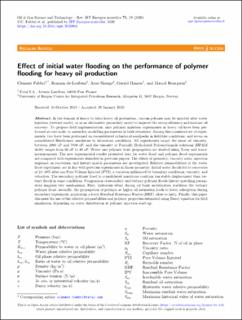Effect of initial water flooding on the performance of polymer flooding for heavy oil production
Journal article, Peer reviewed
Published version

Åpne
Permanent lenke
https://hdl.handle.net/11250/2763106Utgivelsesdato
2020Metadata
Vis full innførselSamlinger
- Department of Chemistry [433]
- Registrations from Cristin [9766]
Sammendrag
In the domain of heavy to extra heavy oil production, viscous polymer may be injected after water injection (tertiary mode), or as an alternative (secondary mode) to improve the sweep efficiency and increase oil recovery. To prepare field implementation, nine polymer injection experiments in heavy oil have been performed at core scale, to assess key modelling parameters in both situations. Among this consistent set of experiments, two have been performed on reconstituted cylindrical sandpacks in field-like conditions, and seven on consolidated Bentheimer sandstone in laboratory conditions. All experiments target the same oil viscosity, between 2000 cP and 7000 cP, and the viscosity of Partially Hydrolyzed Polyacrylamide solutions (HPAM 3630) ranges from 60 cP to 80 cP. Water and polymer front propagation are studied using X-ray and tracer measurements. The new experimental results presented here for water flood and polymer flood experiments are compared with experiments described in previous papers. The effects of geometry, viscosity ratio, injection sequence on recoveries, and history match parameters are investigated. Relative permeabilities of the water flood experiment are in line with previous experiments in linear geometry. Initial water floods led to recoveries of 15–30% after one Pore Volume Injected (PVI), a variation influenced by boundary conditions, viscosity, and velocities. The secondary polymer flood in consolidated sandstone confirms less stable displacement than tertiary floods in same conditions. Comparison of secondary and tertiary polymer floods history matching parameters suggests two mechanisms. First, hysteresis effect during oil bank mobilization stabilizes the tertiary polymer front; secondly, the propagation of polymer at higher oil saturation leads to lower adsorption during secondary experiment, generating a lower Residual Resistance Factor (RRF), close to unity. Finally, this paper discusses the use of the relative permeabilities and polymer properties estimated using Darcy equation for field simulation, depending on water distribution at polymer injection start-up.
